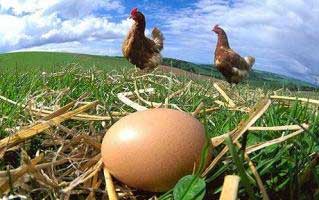Laying hens may use higher levels of DDGS

According to the Poultry Science Association (PSA), researchers at the University of Nebraska have identified one possible approach that may be effective for laying hens: increasing the percentage of dried distillers grains with solubles (DDGS) used in hens’ diets.
DDGS serve as a valuable source of energy, protein and amino acids in poultry diets.
The researchers – Drs. Mahmoud Masa’deh, Sheila Purdum, and Katherine Hanford – detail their findings in a recent issue of the journal Poultry Science (“Dried Distillers Grains with Solubles in Laying Hen Diets”; Poult. Sci. 2011 90: 1960-1966).
“Dried distillers grains with solubles have previously been shown to be a valuable and, especially given current prices of corn and soybean meal, affordable ingredient in poultry diets.
“Current usage levels of DDGS in poultry diets typically range from 5% up to 10%. What our recent study has shown is that growers can safely explore levels of DDGS in their diets for laying hens up to 15%, and perhaps as high as 25%, with no negative effects on feed intake, egg production, or other key metrics, and with improved yolk color at the higher levels,” said Dr. Purdum, one of the study’s authors.
Subsequent studies will also look at the impact of replacement rations containing DDGS for pullets, noted Dr. Purdum.
Experimental approach
The research team’s study comprised two egg production phases, during which diets were formulated to include 0, 5, 10, 15, 20, or 25% corn DDGS.
The only difference between the diets in Phase 1 (week 24-46) and Phase 2 (week 47-76) was that in Phase 1, the diets were formulated on a fixed lysine and TSAA (total sulphur amino acids) level.
During the second phase, the diets were designed to keep lysine and methionine at a fixed level, but the TSAA levels were allowed to increase due to higher cysteine levels in DDGS.
Results
The researchers found that neither feed intake nor egg production were affected by dietary DDGS concentration in either phase of the study.
In Phase 1, however, researchers observed that increases in DDGS levels correlated with a roughly linear decrease in egg weight. However, the negative correlation between DDGS and egg weight was not seen in Phase 2 of the study.
According to the study’s authors, differences in amino acid levels and potential bioavailability as well as changing amino acid balance in Phases 1 and 2 could have been the reason for the reduction in egg weight only during Phase 1.
The authors found no differences in Haugh units due to DDGS levels in either production phase.
In addition, the authors observed a linear increase in the retention of nitrogen and phosphorous with increasing levels of DDGS; the output per kilogram (as measured in the hens’ excreta) of these elements, however, decreased linearly as DDGS increased.
This result is opposite to what was reported by other researchers, whose work focused on broiler chicks.
Egg yolk colour
One difference the researchers consistently found throughout the study was that egg yolk colour increased linearly with increased dietary levels of DDGS, reaching its greatest Roche colour fan score of 7.2 in eggs from hens fed the diet containing 25% DDGS.
According to the authors, this indicates that xanthophylls in the DDGS were “highly available.”
They also point out that the xanthophyll content of dried distillers grains with solubles is approximately three times that of corn by weight (34 mg/kg vs. 10.62 mg/kg, respectively).
This finding may be useful for producers selling eggs in markets where there is a consumer preference for increased yolk pigmentation.











